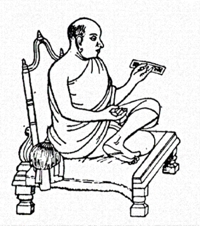 Acharya Hemchandra was born in 1088 A.D. into the Modha Vanik (merchant) caste, in the town of Dhandhuka, sixty miles from the city Ahmedabad in Gujarat State. His parents were Chachadev and Pahini. When Pahini was pregnant, she had a beautiful dream. She narrated her dream to Acharya Devasuri, who was in Dhandhuka at that time. The acharya said that Pahini was to give birth to a son who would make great progress in the areas of spiritual knowledge, intuition, and conduct. Upon the birth the child was named Changdeva.
Acharya Hemchandra was born in 1088 A.D. into the Modha Vanik (merchant) caste, in the town of Dhandhuka, sixty miles from the city Ahmedabad in Gujarat State. His parents were Chachadev and Pahini. When Pahini was pregnant, she had a beautiful dream. She narrated her dream to Acharya Devasuri, who was in Dhandhuka at that time. The acharya said that Pahini was to give birth to a son who would make great progress in the areas of spiritual knowledge, intuition, and conduct. Upon the birth the child was named Changdeva.
The next time Acharya Devasuri was in Dhandhuka, he saw Pahini carrying her son. He said to Pahini, "Let me take care of this brilliant son. He is destined to be a great spiritual leader." However, he could not convince her to give him her son. The Acharya kept pursuing and reminding that her son would become a famous monk and would glorify the Jain Order. Again, he requested that she should sacrifice her self-interest and love for the child for the good of the people. Ultimately, Pahini let the Acharya take her son with him.
He initiated Changdeva into monkshood and named him Somachandra. The disciple was very intelligent and soon mastered the darshanas, scriptures, nyaya, grammar, etc. At the same time, he cultivated excellent virtues like forbearance, tolerance, holiness, simplicity, discipline, chastity, and generosity. Somachandra was incomparable in administration and efficiency. Acharaya Devasuri made Somachandra an acharya when he was only twenty-one years old. At that time, he was given the name Hemchandra Acharya.
The fame of Hemchandra's efficacy and knowledge gradually spread everywhere. The noble culture was on the rise in Gujarat due to the ability of Hemchandra and the cooperation of King Siddharaja of Gujarat. King Siddharaja was succeeded by Kumarpal. Hemchandra had predicted seven years earlier that Kumarpal would be the king. Also, the acharya had once saved Kumarpal's life. Therefore, Kumarpal considered Hemchandra his spiritual teacher (guru) and benefactor. Kumarpal gave him the exceptional honor and sought his advice in the shaping of his kingdom in Gujarat. In a very short time, Gujarat became a center of non-violence, learning, and good culture.
Hemchandra did not only think of the development of his own career, but always thought of the universal welfare. In spite of this, some Brahmins were very jealous about this and they were trying to disgrace Hemchandracharya and Jainism. Therefore, some Brahmins approached King Kumarpal and said, "Hemchandracharya is a very egoistic person and he does not respect Hindu Gods." King Kumarpal was not ready to accept these views about his spiritual teacher, Hemchandracharya. Brahmins requested King Kumarpal that he should invite Hemchandracharya to come to the temple of Lord Shiva (God of destruction). The purpose of this was to humiliate Hemchandracharya because they thought he would not go to the temple of Lord Shiva and bow down to him. When Hemchandracharya came, King Kumarpal said, "We would go to the temple of Lord Shiva." He accepted the offer without any hesitation. Brahmins were happy in their mind thinking that they would be able to make their point today and glorify their religion. Yet, they were wrong. They underestimated Hemchandracharya. To the surprise of those Brahmins, Hemchandracharya bowed down in front of Lord Shiva but by saying,
"Bhavbijaskurajanana ragadayah kshaymupagata yasya; Brahma va Vishnurva haro Jino va namastasmai."
Meaning, "I am bowing down to that god, who has destroyed the passions like attachment (Rag) and hatred (Dwesh) which are the cause of worldly life, whether he is Brahma, Vishnu, or Jina."
This showed that indeed the Acharya was genius and had a broad-minded attitude based on basic Jain principles. Under Hemchandra's influence, King Kumarpal accepted the Jainism. He prohibited violence and killing of any animal in his kingdom. King Kumarpal made many laws that nurtured the Jain religion. Vegetarianism was found not only in the Jains, but also in all the people of Gujarat. Jainism became the land of the region.
Hemchandra composed several literary works that included many verses. The Acharya was the first one to put non-violence on a political platform. He was the architect of the greatness and unity of Gujarat. In the field of metaphysics, he was a Yogi. His work Yoga-Shastra, a treatise on yoga, is very famous. People called him 'Kali-kala Sarvajna' meaning ‘all-knower in the dark period’. He died in 1173 A. D. at the age of eighty-four. The Jain culture still shines brightly in Gujarat, due to the influence of the literary works contributed by the great Acharya Hemchandra.